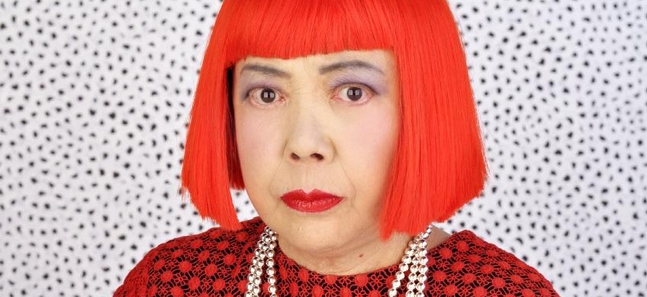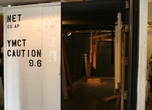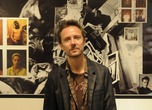Yayoi Kusama: the interview
The bewigged artist talks madness, protests, nakedness and polka dots

© Yayoi Kusama Studio
Posted: Wed Jan 25 2012
It’s the end of a three-day trip to Tokyo and I’m with a small press party in the studio of 82-year-old Japanese artist Yayoi Kusama. Having suffered nervous disorders and hallucinations since childhood, Kusama has chosen to live in a Tokyo psychiatric hospital for the past 38 years, and has built herself a studio opposite. Health permitting, she still makes a daily journey from the hospital to her studio to paint.
We’re surrounded by racks stacked with Kusama’s most recent works. In the past two years she has completed more than 130 new canvases – single-colour backgrounds covered in her unique visual language of repeat patterns of dots, lines and figurative elements that include faces, eyes and flowers. There’s been a certain amount of uncertainty about our meeting with the highly respected but unpredictable artist from the outset. Will her health be up to it? Will she change her mind and cancel at the last minute? Will she be in the mood to answer questions?
Happily, when Kusama arrives, accompanied by a team of assistants, she doesn’t disappoint. She may be a somewhat stooped and shuffling figure, but these obvious physical frailties and her diminutive size are offset by her attire: a floor-length red-and-white spotty dress, a black-and-red leopard-print scarf, bright red lipstick and an even brighter crimson bobbed wig. With a major retrospective about to open at London’s Tate Modern after a successful run at the Pompidou Centre in Paris, and an exhibition of recent work currently on display at the National Museum of Art, Osaka, she also has plenty to talk about.
Yayoi Kusama was born in 1929 in the city of Matsumoto, Nagano Prefecture, where her middle-class parents worked in seed production. In a similar scenario to that experienced by the young Louise Bourgeois, the marital infidelities of Kusama’s father had a lasting impact on his free-spirited daughter. ‘My father had lots of lovers and I had to spy on him for my mother. Because my mother was very angry it made even the idea of sex very traumatic for me. My work, including the naked happenings, is always about overcoming that bad experience. And my visual language all still comes from my hallucinations, which I have seen since my childhood.’
The young Kusama found some escape from family life in art and spent a year between 1948 and 1949 studying traditional Japanese Nihonga painting. But such a strict discipline and hierarchical master-pupil relationship didn’t suit the independent-minded Kusama, and she chose instead to continue experimenting with her own painting – early evidence of a determination that has driven, and possibly at times hindered, her success.
Kusama’s early works mixed traditional Japanese painting styles with Western influences, the latter gathered from art books and European and American magazines. It was a particular interest in the work of US artist Georgia O’Keeffe that eventually led to Kusama leaving Japan for America. ‘I first came across an image of hers in a book of images of animal bones in the desert,’ she says. ‘I thought that it was wonderful and wanted to communicate with her.’ Kusama went to the American embassy in Tokyo, obtained O’Keeffe’s address and sent her a letter with some of her drawings, resulting in a longstanding correspondence between the two.
By the mid-1950s, Kusama was successfully exhibiting her work in Japan but had already resolved that New York was the place to further her career and, despite knowing no one, she moved there in 1958. Using a repeating, curved brushstroke and working as obsessively as ever, Kusama covered canvases and other surfaces in abstract grid-like patterns known as ‘infinity nets’. She also created installations by covering furniture and other objects with soft phallic protuberances which she called her ‘Sex Obsession Series’, similarly covering objects with dry pasta in her ‘Food Obsession Series’. Painting spots (her signature motif, decades before Damien Hirst) also became a recurring practice. Kusama now says that these works were driven by her hallucinations. But although her nervous disorders have no doubt always fed into her art (in analytical terms she’s burying herself in the process of repeating what she fears, in order to obliterate both her fears and herself), those works, which quickly began to get her noticed in New York, also chimed with experiments in abstract expressionism, conceptual art and monochrome minimalism.
In New York Kusama was both an outsider and very poor – ‘At times I had to look for things to eat in the garbage’ – but she also became part of the art world avant-garde. Frank Stella, Joseph Cornell and Donald Judd were among her friends and she exhibited alongside, and arguably had an influence on, more famous contemporaries including Claes Oldenburg and Andy Warhol. Like Warhol, Kusama was both socially shy and a canny self-publicist. She wasn’t averse to putting on her best kimono to make the most of her ‘exotic’ Oriental status when it could be used to gain attention and she made sure that she was photographed at parties with all the right people.
She also marketed her events, films and other works, including her unconventional fashion designs (many featuring holes in revealing places), by setting up Kusama Enterprises in 1969, a commercial outlet that is still going strong; her studio includes a room filled with Kusama-themed bags, T-shirts and limited editions. Like Warhol, Kusama preferred to be the orchestrator of events rather than a mere participant. In the mid-to-late 1960s she organised experimental performances and socio-political happenings that included ticketed orgies during which the artist painted naked dancers with dots. ‘Some of the naked happenings in New York were against the Vietnam War,’ she says, ‘because the human body is too beautiful to be killed in that way. There were also naked anti-tax happenings because nudism doesn’t cost money.’
By the end of the 1960s all this intense activity had taken its toll on Kusama. Not only was she mentally exhausted but attitudes had moved on, and rather than being viewed as a driven, avant-garde artist she was beginning to be seen as an over-exposed, attention-seeking one. A two-month trip to Japan in 1970 only reinforced this when her attempt to stage happenings there met with a lukewarm response. Most Japanese people at that time were completely unable to comprehend her ideas about nudity and free love. That Kusama has been able to build up her international career again, including success as a novelist and poet, after her permanent return here in 1973, is evidence that she is both an innovator and highly driven. And it’s partly Kusama’s ability to embody different extremes that makes her such an interesting artist. Few other contemporary artists have been able to accommodate a psychiatric nervous disorder (Kusama still receives medication at the hospital in which she lives) as part of a highly successful commercial career.
Kusama may no longer be physically protesting, but her belief in art as a means of political and personal expression remains strong – and seems increasingly relevant with the current wave of international protest and Occupy movements. ‘Artists should protest all the time,’ she says, ‘because there are still many problems in the world with democracy and human rights and because there is a big gap between the wealthy and poor. In Japan there have been a lot of political and social changes in recent decades and we are still dealing with the 2011 earthquake, which is why I support younger artists by donating money and work to cultural foundations.’
Despite our concerns for Kusama’s stamina, at the end of a full afternoon of interviews she is still full of enthusiasm. ‘I am really moved by your visit today because it’s very important to me to still be able to communicate through my paintings.’ Given the fragile nature of both her physical and mental health, I wonder if the attention ever gets too much. Does she still enjoy being famous? I should have known the response: ‘Of course – I would like to be more famous!’
Shinjuku Isetan's Yayoi Kusama silkscreen print exhibition runs until January 31. Kusama will unveil a new work at Roppongi Art Night, March 24-25
Tweets
- About Us |
- Work for Time Out |
- Send us info |
- Advertising |
- Mobile edition |
- Terms & Conditions |
- Privacy policy |
- Contact Us
Copyright © 2014 Time Out Tokyo














Add your comment